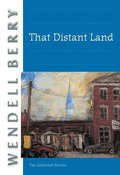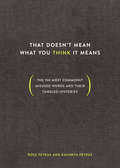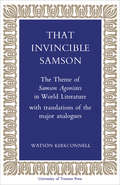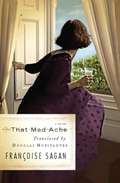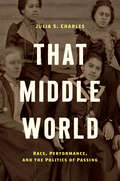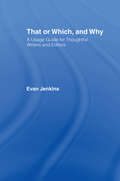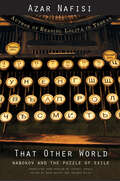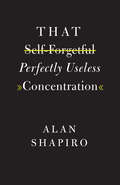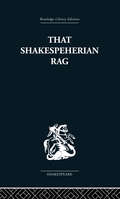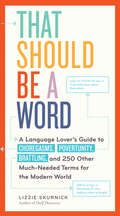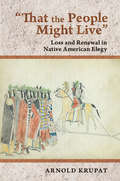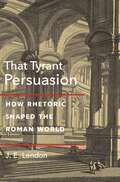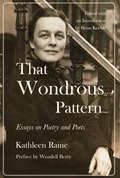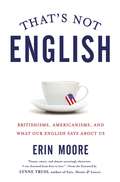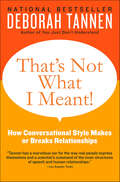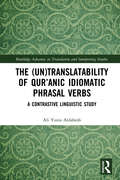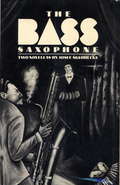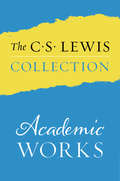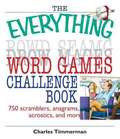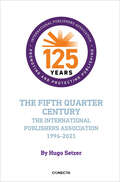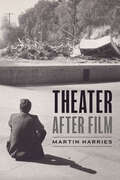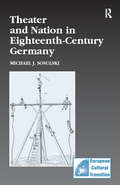- Table View
- List View
That Distant Land: The Collected Stories (Port William Ser.)
by Wendell BerryOriginally published in 2005, That Distant Land brings together twenty–three stories from the Port William Membership. Arranged in their fictional chronology, the book is not an anthology so much as it is a coherent temporal mapping of this landscape over time, revealing Berry’s mastery of decades of the life lived alongside this clutch of interrelated characters bound by affection and followed over generations.This volume combines the stories found in The Wild Birds (1985), Fidelity (1992), and Watch with Me (1994), together with a map and a charting of the complex and interlocking genealogies.
That Doesn't Mean What You Think It Means: The 150 Most Commonly Misused Words and Their Tangled Histories
by Ross Petras Kathryn PetrasAn entertaining and informative guide to the most common 150 words even smart people use incorrectly, along with pithy forays into their fascinating etymologies and tangled histories of use and misuse. Even the most erudite among us use words like apocryphal, facetious, ironic, meteorite, moot, redundant, and unique incorrectly every day. Don’t be one of them. Using examples of misuse from leading newspapers, prominent public figures and famous writers, among others, language gurus Ross Petras and Kathryn Petras explain how to avoid these perilous pitfalls in the English language. Each entry also includes short histories of how and why these mistake have happened, some of the (often surprisingly nasty) debates about which uses are (and are not) mistakes, and finally, how to use these words correctly … or why to not use them at all. By the end of this book, every literati will be able to confidently, casually, and correctly toss in an “a priori” or a “limns” without hesitation.
That Invincible Samson: The Theme of Samson Agonistes in World Literature
by Watson KirkconnellThis work examines the more than one hundred analogues of Samson Agonistes, about half of them written earlier than Milton's drama. The author has gone back in every instance to primary sources, and examined all treatments of Milton's theme, in all languages, for their intrinsic interest and merit. While he has not entirely omitted a discussion of source relationships, his concern here has been chiefly with analogues. In Part I of the book the author compares five pre-Miltonic works, which he has translated, in whole or in part, from the original Latin, Dutch, and Italian. In Part II, a descriptive catalogue, he comments on the significance, to Miltonists and to the general reader, of the analogues. He traces the purposes beyond mere theatre in the different versions of the play: versions prior to 1670 contain many overtones of personal, national, or theological significance, while, after 1671, there is a rapid shift away from religious or moral presentation to a more strictly theatrical entertainment. Dr. Kirkconnell believes that this shift in interest has obscured from most of the critics of later centuries the tone and tradition of this great drama. The nineteenth and twentieth centuries have seen dozens of versions of the old play theme, nearly all of them wholly disregarding any inner drama of the spirit, and stressing extrovert aspects of Strength, Beauty, and Sex. As a whole, the analogues will reveal the variety that playwrights have found possible in the ancient theme. The author concludes that Milton's treatment is the noblest ever written, surpassing all others in literary quality and in the nature of the dramatic conflict it describes.
That Mad Ache: A Novel
by Douglas R. Hofstadter Francoise SaganThat Mad Ache, set in high-society Paris in the mid-1960's, recounts the emotional battle unleashed in the heart of Lucile, a sensitive but rootless young woman who finds herself caught between her carefree, tranquil love for 50-year-old Charles, a gentle, reflective, and well-off businessman, and her sudden wild passion for 30-year-old Antoine, a hot-blooded, impulsive, and struggling editor. As Lucile explores these two versions of love, she vacillates in confusion, but in the end she must choose, and her heart's instinct is surprising and poignant. Originally published under the title La Chamade, this new translation by Douglas Hofstadter returns a forgotten classic to English. In Translator, Trader, Douglas Hofstadter reflects on his personal act of devotion in rewriting Françoise Sagan's novel La Chamade in English, and on the paradoxes that constantly plague any literary translator on all scales, ranging from the humblest of commas to entire chapters. Flatly rejecting the common wisdom that translators are inevitably traitors, Hofstadter proposes instead that translators are traders, and that translation, like musical performance, deserves high respect as a creative act. In his view, literary translation is the art of making subtle trades in which one sometimes loses and sometimes gains, often both losing and gaining at the same time. This view implies that there is no reason a translation cannot be as good as the original work, and that the result inevitably bears the stamp of the translator, much as a musical performance inevitably bears the stamp of its artists. Both a companion to the beloved Sagan novel and a singular meditation on translation, Translator, Trader is a witty and intimate exploration of words, ideas, communication, creation, and faithfulness.
That Middle World: Race, Performance, and the Politics of Passing
by Julia S. CharlesIn this study of racial passing literature, Julia S. Charles highlights how mixed-race subjects invent cultural spaces for themselves—a place she terms that middle world—and how they, through various performance strategies, make meaning in the interstices between the Black and white worlds. Focusing on the construction and performance of racial identity in works by writers from the antebellum period through Reconstruction, Charles creates a new discourse around racial passing to analyze mixed-race characters' social objectives when crossing into other racialized spaces. To illustrate how this middle world and its attendant performativity still resonates in the present day, Charles connects contemporary figures, television, and film—including Rachel Dolezal and her Black-passing controversy, the FX show Atlanta, and the musical Show Boat—to a range of nineteenth- and early twentieth-century literary texts. Charles's work offers a nuanced approach to African American passing literature and examines how mixed-race performers articulated their sense of selfhood and communal belonging.
That or Which, and Why: A Usage Guide for Thoughtful Writers and Editors
by Evan JenkinsThat or Which, and Why is an insightful and witty guide to writing. Based on Evan Jenkins's long-running column 'Language Corner' in Columbia Journalism Review, the book is compiled of brief, alphabetically arranged entries on approximately 200 major writing stumbling blocks, from the wonderful world of 'that' and 'which' to trickier terrain like the correct usage of common idiomatic expressions.Working from his experiences as a newsroom editor and teacher, Jenkins' humorous tone puts the reader at ease, unlike many of the writing and usage guides out there that are off-putting in their rigidity and dogmatism. He takes the 'we're-all-in-this-together' approach to teaching better writing - maintaining a light tone throughout the book and emphasizing flexibility and easy-to-use guidelines rather than delivering orders from Grammar-on-high.
That Other World: Nabokov and the Puzzle of Exile
by Azar NafisiThe foundational text for the acclaimed international best seller Reading Lolita in Tehran&“Empathetic, incisive. . . . A sweeping overview of Nabokov's major works. . . . Graceful [and] discerning.&”—Kirkus ReviewsThe ruler of a totalitarian state seeks validation from a former schoolmate, now the nation&’s foremost thinker, in order to access a cultural cache alien to his regime. A literary critic provides commentary on an unfinished poem that both foretells the poet&’s death and announces the critic&’s secret identity as the king of a lost country. The greatest of Vladimir Nabokov&’s enchanters—Humbert—is lost within the antithesis of a fairy story, in which Lolita does not hold the key to his past but rather imprisons him within the knowledge of his distance from that past.In this precursor to her international best seller Reading Lolita in Tehran, Azar Nafisi deftly explores the worlds apparently lost to Nabokov&’s characters, their portals of access to those worlds, and how other worlds hold a mirror to Nabokov&’s experiences of physical, linguistic, and recollective exile. Written before Nafisi left the Islamic Republic of Iran, and now published in English for the first time and with a new introduction by the author, this book evokes the reader&’s quintessential journey of discovery and reveals what caused Nabokov to distinctively shape and reshape that journey for the author.
That Self-Forgetful Perfectly Useless Concentration
by Alan ShapiroMore than a gathering of essays, That Self-Forgetful Perfectly Useless Concentration is part memoir, part literary criticism, and an artful fusion of the two. It is an intimate portrait of a life in poetry that only Alan Shapiro could have written. In this book, Shapiro brings his characteristic warmth, humor, and many years as both poet and teacher to bear on questions surrounding two preoccupations: the role of conventions--of literary and social norms--in how we fashion our identities on and off the page, and how suffering both requires and resists self-expression. He sketches affectionate portraits of his early teachers, revisits the deaths of his brother and sister, and examines poems that have helped him navigate troubled times. Integrating storytelling and literary analysis so seamlessly that art and life become extensions of each other, Shapiro embodies in his lively prose the very qualities he celebrates in the poems he loves. Brimming with wit and insight, this is a book for poets, students and scholars of poetry, teachers of literature, and everyone who cares about the literary arts and how they illuminate our personal and public lives.
That Shakespeherian Rag: Essays on a critical process
by Terence HawkesFirst published in 1986. This collection of essays focuses on the ways in which our society 'processes' Shakespeare and the purposes for which this seems to be done. The case is made by examining the work of four highly influential critics: A C Bradley, Walter Raleigh, T S Eliot and John Dover Wilson. Terence Hawkes asks whether, beyond the readings to which the plays may be subjected, there lies any final, authoritative or essential meaning to which we can ultimately turn, concluding that jazz music offers the most fruitful model for twentieth-century criticism.
That Should Be a Word: A Language Lover's Guide to Choregasms, Povertunity, Brattling, and 250 Other Much-Needed Terms for the Modern World
by Lizzie SkurnickFinally there’s a word for it: Fidgital—excessively checking one’s devices. Martyrmony—staying married out of duty. Author of the highly popular “That Should Be a Word” feature in the New York Times Magazine, Lizzie Skurnick delights word lovers with razor-sharp social commentary delivered via clever neologisms. That Should Be a Word is a compendium of 244 of Skurnick’s wittiest wordplays—more than half of them new—arranged in ingenious diagrams detailing their interrelationships. Complete with definitions, pronunciations, usage examples, and illustrations, That Should Be a Word features words on our obsession with food: carbiter—one who asserts that someone else cannot be hungry. On social media, like twiticule—to mock someone in 140 characters. On the modern family, like brattle—to discuss one’s children at great length, which leads to words like spamily—Facebook or Twitter updates about kids—and spawntourage—a group of approaching strollers. From highlighting the profound financial anxiety of a post-recession society (bangst) to mocking the hyper-vain celebrity circle that abstains from anything of import (celebracy), That Should Be a Word delves deep into all the most humorous, and maddening, aspects of life in the 21st century.
That Summer in Paris: Memories of Tangled Friendships with Hemingway, Fitzgerald, and Some Others
by Morley Callaghan"That Summer In Paris" brings to the fore the fabulous summer of 1929 when the literary capital of North America moved to La Rive Gauche--the Left Bank of the Seine River--in Paris. Ernest Hemingway was reading proofs of "A Farewell to Arms", and a few blocks away F. Scott Fitzgerald was struggling with "Tender Is the Night". As his first published book rose to fame in New York, Morley Callaghan arrived in Paris to share the felicities of literary life, not just with his two friends, Hemingway and Fitzgerald, but also with fellow writers James Joyce, Ford Madox Ford, and Robert McAlmon. Amidst these tangled relations, some friendships flourished while others failed.
"That the People Might Live": Loss and Renewal in Native American Elegy
by Arnold KrupatThe word "elegy" comes from the Ancient Greek elogos, meaning a mournful poem or song, in particular, a song of grief in response to loss. Because mourning and memorialization are so deeply embedded in the human condition, all human societies have developed means for lamenting the dead, and, in "That the People Might Live" Arnold Krupat surveys the traditions of Native American elegiac expression over several centuries.Krupat covers a variety of oral performances of loss and renewal, including the Condolence Rites of the Iroquois and the memorial ceremony of the Tlingit people known as koo'eex, examining as well a number of Ghost Dance songs, which have been reinterpreted in culturally specific ways by many different tribal nations. Krupat treats elegiac "farewell" speeches of the eighteenth and nineteenth centuries in considerable detail, and comments on retrospective autobiographies by Black Hawk and Black Elk.Among contemporary Native writers, he looks at elegiac work by Linda Hogan, N. Scott Momaday, Gerald Vizenor, Sherman Alexie, Maurice Kenny, and Ralph Salisbury, among others. Despite differences of language and culture, he finds that death and loss are consistently felt by Native peoples both personally and socially: someone who had contributed to the People's well-being was now gone. Native American elegiac expression offered mourners consolation so that they might overcome their grief and renew their will to sustain communal life.
That Tyrant, Persuasion: How Rhetoric Shaped the Roman World
by J. E. LendonHow rhetorical training influenced deeds as well as words in the Roman EmpireThe assassins of Julius Caesar cried out that they had killed a tyrant, and days later their colleagues in the Senate proposed rewards for this act of tyrannicide. The killers and their supporters spoke as if they were following a well-known script. They were. Their education was chiefly in rhetoric and as boys they would all have heard and given speeches on a ubiquitous set of themes—including one asserting that &“he who kills a tyrant shall receive a reward from the city.&” In That Tyrant, Persuasion, J. E. Lendon explores how rhetorical education in the Roman world influenced not only the words of literature but also momentous deeds: the killing of Julius Caesar, what civic buildings and monuments were built, what laws were made, and, ultimately, how the empire itself should be run.Presenting a new account of Roman rhetorical education and its surprising practical consequences, That Tyrant, Persuasion shows how rhetoric created a grandiose imaginary world for the Roman ruling elite—and how they struggled to force the real world to conform to it. Without rhetorical education, the Roman world would have been unimaginably different.
That Wondrous Pattern: Essays on Poetry and Poets
by Kathleen Raine“There is no exaggeration in pointing out that these essays are addressed to the soul of the reader. They are not academic exercises in erudition as a contribution to ‘Eng. Lit.’” —from the introduction by Brian Keeble Kathleen Raine was one of the greatest British poets of the last century. Born to a deeply literary and spiritual household, she went on to study at Cambridge, where she met Jacob Bronowski, William Empson, and Malcolm Lowry. A dedicated neoPlatonist, she studied and presented the works of Thomas Taylor and wrote seminal books on William Blake. With Keith Critchlow, Brian Keeble, and Philip Sherrard, she founded, in 1981, the Temenos Academy of Integral Studies, its journal Temenos, and, later, the Temenos Academy Review. HRH The Prince of Wales became the patron of the academy in 1997.For our new selection, That Wondrous Pattern, Raine offers sixteen essays that range from “The Inner Journey of the Poet” and “What Is Man?” to essays on Blake, Wordsworth, Hopkins, Yeats, Eliot, and several others. The centerpiece, “What Is the Use of Poetry?”, is a rigorous defense of the great art. Editor Brian Keeble himself contributes a fascinating introduction to Raine’s work, and Wendell Berry, a colleague and friend of hers, offers a preface.All who spend time in the presence of this wonderful writer will leave newly entranced with the art and use of the beautiful, convinced that “it is only in moments when we transcend ourselves that we can know anything of value.
That's Not English
by Erin Moore Lynne TrussAn expat's witty and insightful exploration of English and American cultural differences through the lens of language that will leave readers gobsmackedIn That's Not English, the seemingly superficial differences between British and American English open the door to a deeper exploration of a historic and fascinating cultural divide. In each of the thirty chapters, Erin Moore explains a different word we use that says more about us than we think. For example, "Quite" exposes the tension between English reserve and American enthusiasm; in "Moreish," she addresses our snacking habits. In "Partner," she examines marriage equality; in "Pull," the theme is dating and sex; "Cheers" is about drinking; and "Knackered" covers how we raise our kids. The result is a cultural history in miniature and an expatriate's survival guide. American by birth, Moore is a former book editor who specialized in spotting British books--including Eats, Shoots & Leaves--for the US market. She's spent the last seven years living in England with her Anglo American husband and a small daughter with an English accent. That's Not English is the perfect companion for modern Anglophiles and the ten million British and American travelers who visit one another's countries each year.
That's Not English: Britishisms, Americanisms, and What Our English Says About Us
by Lynne Truss Erin MooreAn expat's witty and insightful exploration of English and American cultural differences through the lens of language that will leave readers gobsmackedIn That's Not English, the seemingly superficial differences between British and American English open the door to a deeper exploration of a historic and fascinating cultural divide. In each of the thirty chapters, Erin Moore explains a different word we use that says more about us than we think. For example, "Quite" exposes the tension between English reserve and American enthusiasm; in "Moreish," she addresses our snacking habits. In "Partner," she examines marriage equality; in "Pull," the theme is dating and sex; "Cheers" is about drinking; and "Knackered" covers how we raise our kids. The result is a cultural history in miniature and an expatriate's survival guide. American by birth, Moore is a former book editor who specialized in spotting British books--including Eats, Shoots & Leaves--for the US market. She's spent the last seven years living in England with her Anglo American husband and a small daughter with an English accent. That's Not English is the perfect companion for modern Anglophiles and the ten million British and American travelers who visit one another's countries each year.
That's Not What I Meant!: How Conversational Style Makes or Breaks Relationships
by Deborah TannenThe bestselling linguistics professor examines how we communicate with each other and how you can maintain an effective conversation.At home, on the job, in a personal relationship, it’s often not what you say but how you say it that counts.Deborah Tannen revolutionized our thinking about relationships between women and men in her #1 bestseller You Just Don’t Understand. In That’s Not What I Meant!, the internationally renowned sociolinguist and expert on communication demonstrates how our conversational signals—voice level, pitch and intonation, rhythm and timing, even the simple turns of phrase we choose—are powerful factors in the success or failure of any relationship. Regional speech characteristics, ethnic and class backgrounds, age, and individual personality all contribute to diverse conversational styles that can lead to frustration and misplaced blame if ignored—but provide tools to improve relationships if they are understood.At once eye-opening, astute, and vastly entertaining, Tannen’s classic work on interpersonal communication will help you to hear what isn’t said and to recognize how your personal conversational style meshes or clashes with others. It will give you a new understanding of communication that will enable you to make the adjustments that can save a conversation . . . or a relationship.“Tannen combines a novelist’s ear for the way people speak with a rare power of original analysis. . . . Fascinating.” —Oliver Sacks“We are, all of us, foreigners to each other: editor and writer, man and woman, Californian and New Yorker, friend and friend. Dr. Tannen shows us how different we are, and how to speak the same language.” —Jack Rosenthal, Pulitzer Prize winner and editor, The New York Times“Tannen has a marvelous ear for the way real people express themselves and a scientist’s command of the inner structures of speech and human relationships.” —Los Angeles Times
The: A Contrastive Linguistic Study (Routledge Advances in Translation and Interpreting Studies)
by Ali Yunis AldaheshQur’anic idiomaticity, in its all aspects, poses a great deal of challenge to Qur’an readers, learners, commentators, and translators. One of the most challenging aspects of Qur’anic idiomaticity is Qur’anic idiomatic phrasal verbs, where significances of proper Arabic verbs are entirely fused with significances of prepositions following them to produce new significances that have nothing to do with the basic significances of those verbs and prepositions. By examining a corpus of ten of the most influential English translations of the Qur’an, this study scrutinizes how some translators of the Qur’an have dealt with the phenomenon of Qur’anic idiomatic phrasal verbs, the difficulties that they have encountered when translating them into English, and the strategies that they have employed in their attempts to overcome the inherent ambiguity of such expressions and provide their functional-pragmatic equivalents for English readership. The study proposes a working model for analysing and assessing the translation of the Qur’anic idiomatic phrasal verbs and provides a number of theory-based recommendations for translators in general and Qur’an translators in particular.
THE BASS SAXOPHONE
by Josef SkvoreckyFirst published in 1980, The Bass Saxophone was chosen as Book of the Year by The Guardian. This internationally acclaimed classic of jazz literature is now available in a handsome new edition with a new contribution by the author. As an introduction to these two novellas, Skvorecky writes a remarkable personal memoir of his jazz-obsessed youth under two dictatorships. (2001)
the C. S. Lewis Collection: Academic Works
by C. S. LewisThe Eight Titles Include: An Experiment in Criticism; The Allegory of Love; The Discarded Image; Studies in Words; Image and Imagination; Studies in Medieval and Renaissance Literature; Selected Literary Essays; and The Personal Heresy With his trademark warmth and wit, Lewis offers invaluable insight and intellectual delight for readers.Includes:• An Experiment in Criticism• The Allegory of Love• The Discarded Image• Studies in Words• Image and Imagination• Studies in Medieval and Renaissance Literature• Selected Literary Essays• The Personal Heresy
THE EVERYTHING® Word Games Challenge BOOK
by Charles TimmermanChapter themes include: - What's in a Name?- Word Ladders- Inside Words- Logogriphs
The fifth quarter century: The International Publishers Association 1996-2021
by Hugo SetzerTHE INTERNATIONAL PUBLISHERS ASSOCIATION IPA) is the world's largest federation of national, regional and specialist publishers' associations. Through its members, IPA represents thousands of individual publishers around the world who service markets containing more than 5.6 billion people. Based in Geneva, Switzerland, IPA represents the interests of the publishing industry in international fora and wherever publishers' interests are at stake.
THE NEW Writing with a Purpose,Fourteenth Edition
by Joseph F. TrimmerThe book provides comprehensive coverage of the materials and problems basic to the introductory writing course and provides emphasis on the role of purpose in the writing process.
Theater after Film
by Martin HarriesA study of the impact of film and mass culture on drama after World War II. In Theater after Film, Martin Harries argues that after 1945, as cinema became omnipresent in popular culture, theater had to respond to cinema’s hegemony. Theater couldn’t break that hegemony, but it could provide a zone of contestation. Theater made film’s domination of the cultural field visible through hyperbole, refusal, and other strategies, thereby unsettling its power. Postwar theatrical experiment, Harries shows, often channeled and represented film’s mass cultural force, while knowing that it could never possess that force. Throughout the book, Harries brings critical theory into contact with theories of performance. Although Theater after Film treats the theatrical work of many figures, its central focus falls on Tennessee Williams, Samuel Beckett, and Adrienne Kennedy. Discussions of these dramatists consider their ways of addressing spectators, the politics of race between film and theater, and the place of the theatrical apparatus. Readings of these central figures in twentieth-century theater exemplify the book’s historical engagement with the media surround that drama confronted. This confrontation, Harries shows, was central to the development of some of the most continually compelling postwar drama.
Theater and Nation in Eighteenth-Century Germany (Studies in European Cultural Transition)
by Michael J. SosulskiIn 1767, more than a century before Germany was incorporated as a modern nation-state, the city of Hamburg chartered the first Deutsches Nationaltheater. What can it have meant for a German playhouse to have been a national theater, and what did that imply about the way these theaters operated? Michael Sosulski contends that the idea of German nationhood not only existed prior to the Napoleonic Wars but was decisive in shaping cultural production in the last third of the eighteenth century, operating not on the level of popular consciousness but instead within representational practices and institutions. Grounding his study in a Foucauldian understanding of emergent technologies of the self, Sosulski connects the increasing performance of body discipline by professional actors, soldiers, and schoolchildren to the growing interest in German national identity. The idea of a German cultural nation gradually emerged as a conceptual force through the work of an influential series of literary intellectuals and advocates of a national theater, including G. E. Lessing and Friedrich Schiller. Sosulski combines fresh readings of canonical and lesser-known dramas, with analysis of eighteenth-century theories of nationhood and evolving acting theories, to show that the very lack of a strong national consciousness in the late eighteenth century actually spurred the emergence of the German Nationaltheater, which were conceived in the spirit of the Enlightenment as educational institutions. Since for Germans, nationality was a performed identity, theater emerged as an ideal space in which to imagine that nation.
